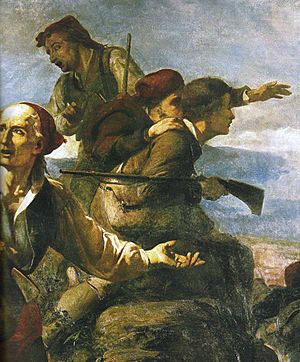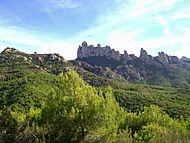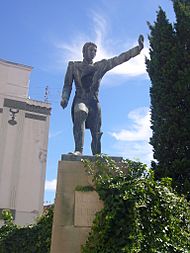Battles of El Bruch facts for kids
Quick facts for kids Battles of El Bruch |
|||||||
|---|---|---|---|---|---|---|---|
| Part of Peninsular War | |||||||
 The ''sometent'' at Bruc (1880), by Ramon Martí Alsina |
|||||||
|
|||||||
| Belligerents | |||||||
| Commanders and leaders | |||||||
| Strength | |||||||
| 3,800–5,000 regulars | 2,000 regulars and militia | ||||||
| Casualties and losses | |||||||
| 6 June: 360 dead 800 wounded 60 captured 1 gun captured Total: 1,220 14 June: 83 dead 274 wounded Total: 357 Grand total: 1,577 |
6 June: 20 dead 80 wounded Total: 100 14 June: 15 dead 50 wounded Total: 65 Grand total: 165 |
||||||
The two battles of the Bruch (Spanish: Batallas del Bruch; Catalan: Batalles del Bruc) were engagements fought successively, at El Bruc, near Barcelona, Catalonia, on 6 and 14 June 1808, during the Peninsular War, by French troops commanded by Brigadier General François de Schwarz and General of Division Joseph Chabran against Spanish volunteers and mercenaries led by General Antoni Franch i Estalella and Joan Baget.
The result of these battles and actions was a Spanish victory.
Contents
Background
The previous month's uprising in Madrid had put Iberia in revolt against French rule.
June 6
The French detachment of 3,800 soldiers under General of Brigade François Xavier de Schwarz left Barcelona on June 4, advancing in the direction of Lleida–Saragossa. A rainstorm that day slowed their march considerably, giving time for local Spanish forces, composed of militia from the neighboring villages, volunteers (sometent), and Swiss and Walloon soldiers from the Barcelona garrison (2,000 men), to mobilize for action. The Spaniards were led by General Antoni Franch i Estalella and deployed along the Bruc Pass.
The resulting stand was a success, and the French under General Schwarz were turned back to Barcelona with the loss of 360 dead, 800 wounded, 60 prisoners, and one gun captured. The Spanish also captured a French Imperial Eagle.
French army

- Schwartz Column - Brigadier-General Francis Xavier Schwartz, Commander-in-Chief
- 1st Regiment Neapolitan of the line (2 battalions - 1940 men)
- 2nd Line Regiment Switzerland (3rd battalion - 580 men)
- 2nd Regiment of the line (3rd battalion - 610 men)
- 1st Regiment of Chasseurs Neapolitan (2 squadrons - 160 men)
- 3rd Regiment Provisional cuirassiers (1 squadron - 100 men)
- 11th Italian artillery company (section 1 - 2 guns)
Spanish forces
- General Antoni Franch i Estalella, Commander-in-Chief
- 260 regulars and militia (Captain José Viñas)
- 200 regulars and militia (Francesc Riera Balaguer)
June 14
A second French sortie on June 14, led by General of Division Joseph Chabran, succeeded only in putting to the torch several buildings in El Bruc after having been defeated and repelled by the Spanish forces led by Joan Baget. The following day, the Spanish attacked the French in their withdrawal to Barcelona, inflicting more than 500 dead and wounded on Chabran's troops.
French army
- First Division - General of Division Joseph Chabran, Commander-in-Chief
- Brigade: Brigadier-General Goulas
- 7th Regiment of the line (2 battalions - 1785 men)
- 16th Regiment of the line (3rd battalion - 789 men)
- Brigade: Brigadier-General Nicolas
- 2nd Regiment of the line (3rd battalion - 610 men)
- 37th Regiment of the line [3rd battalion - 789 men)
- 56th Regiment of the line (4th Battalion - 833 men)
- 93rd Regiment of the line (3rd battalion - 792 men)
- Brigade: Brigadier-General Goulas
Spanish forces
- Commander Joan Baget, Commander-in-Chief
- Four companies of volunteers (soldiers of Extremadura regiment and militia)
- Wallon Guards
- Swiss regiment Wimpffen (300 men)
- 300 militia (Antoni Franch)
- 100 militia (Captain José Viñas)
- Sallen residents (60 men led by the vicar Ramón Mas)
- Patriots (100 men)
- 5 guns
Aftermath
The Spanish conventional warfare proceeded with the Battle of Girona.
See also
 In Spanish: Batalla del Bruch para niños
In Spanish: Batalla del Bruch para niños


